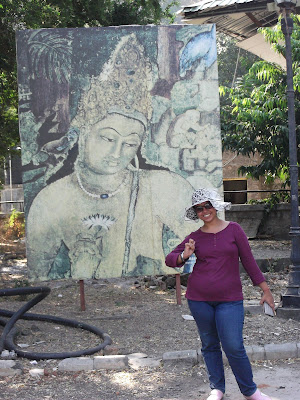It was nearly a year before my trip to France. A few of us decided to go on a trip to Ajanta-Ellora-Aurangabad. It started with an overnight journey in a crowded train to Jalgaon, many people sleepin in the passageway, hoping to secure a berth later in their journey. Shivering against the chill of the early morning, we landed at Jalgaon, taking a bus ride to the caves at Ajanta.
These magnificent caves containing carvings that depict the life of Buddha, and their carvings and sculptures are considered to be the beginning of classical Indian art.
The day was spent in appreciating the art work, and in laboring onward from one cave to another. Some of the art was already familiar thanks to their overwhelming popularity. The most impressive aspect of the Caves is that it was done well over 2000 years ago, by cutting out caves in the massive cliff with nothing but their hammers and chisels.
That evening we traveled from Ajanta to Aurangabad, and checked into a hotel there. We spent the entire night gossiping and I regret having missed the El Classico that night. Waking up early in the morning and getting ready to leave for the Ellora Caves wasn't an easy task, especially considering the labors of the previous day.
The day started with a trip to the Daulatabad Fort which is located at a distance of 15 km northwest of Aurangabad and midway to the Ellora group of caves. Besides the fortifications Daulatabad contains several notable monuments, of which the chief are the Chand Minar and the Chini Mahal.
Our next destination was Ellora, well known for its monumental caves and a World Heritage Site. Ellora represents the epitome of Indian rock-cut architecture. The 34 "caves" – actually structures excavated out of the vertical face of the Charanandri hills.
Buddhist, Hindu and Jain rock-cut temples and viharas and mathas were built between the 5th century and 10th century. The 12 Buddhist (caves 1–12), 17 Hindu (caves 13–29) and 5 Jain (caves 30–34) caves, built in proximity, demonstrate the religious harmony prevalent during this period of Indian history.
Our final destination of the day was the Bibi Ka Maqbara which was commissioned by the Mughal Emperor Aurangzeb in the late 17th century in the memory of his first wife, Dilras Banu Begum.
The Bibi Ka Maqbara bears a striking resemblance to the famous Taj Mahal, the mausoleum of Aurangzeb's mother, Mumtaz Mahal.
After spending an entire day enjoy the architectural beauty of the Daulatabad Fort, the Ellora cave monuments and the Bibi Ka Maqbara, the tired souls returned to their hotel rooms, in order to grab sufficient rest before catching a train back to Mumbai at 6 am in the morning.
It brought and end to a wonderful trip, enjoyed in the company of friends....































